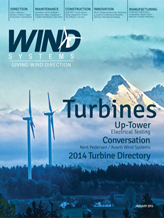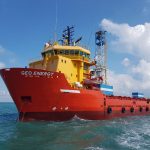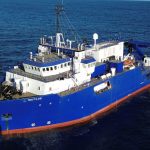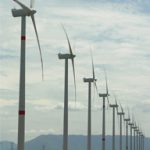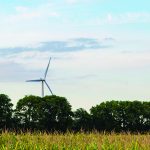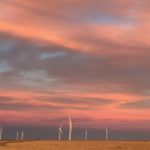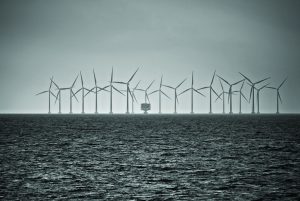Last year was filled with transitional news concerning the wind energy industry, starting with the extension of the Production Tax Credit on Jan. 1, straight through the summer months and beyond, with announcements of new hires at supply-chain plants and project construction starts coming in.
So now that 2013 is in the books, how did the year turn out for U.S. wind energy, and what does it all mean for 2014? Industry numbers for the fourth quarter were not available at the time of this writing, but the American Wind Energy Association’s (AWEA) U.S. Wind Industry Third Quarter 2013 Market Report provided a solid look at how things were shaping up. One of the top takeaways of the 3Q report, in fact, was that American wind energy would finish 2013 with strong momentum for installations in the new year. That momentum, which began building early last year thanks to Congress’s last-minute PTC extension to kick off the year, follows two recent trends.
Year Follows Red-Hot 2012
First, it’s important to step back a year earlier, to 2012, in order to gain a sense of historical perspective on the direction the industry is taking. The U.S. wind energy industry achieved its best year ever in 2012, shattering numerous records. It installed 13,131 megawatts (MW) of capacity and surged past the 60-gigawatt (GW) milestone for total installed wind power capacity. That year the industry invested over $25 billion in private capital to build new wind projects in the U.S., pushing the five-year average annual investment level between 2008 and 2012 to $18 billion.
The result: for the first year ever, wind energy was the number-one source of new electricity generating capacity, contributing 42 percent of all the megawatts the power sector installed. More than 180 wind projects were built.
The 60 GW installed today in the U.S. is enough generating capacity to power the equivalent of 15.2 million American homes. That’s equal to all the households in the states of Colorado, Iowa, Maryland, Michigan, Nevada and Ohio combined. The wind power capacity now deployed can avoid nearly 100 million metric tons of carbon dioxide (CO2) each year—equivalent to more than 4 percent of all power-sector CO2 emissions.
Iowa and South Dakota now produce more than 20 percent of their electricity from wind energy. Furthermore, even some of the nation’s largest state economies have significant wind power penetrations. The Electric Reliability Council of Texas (ERCOT), which operates the grid covering the vast majority of the Lone Star State, achieved the 10-percent milestone for wind energy on its system. Nine states now receive more than 10 percent of their electricity generation from wind energy.
Counter Trend
As project activity progressed at a red-hot pace in 2012, a shorter-term trend emerged, about which the industry urgently warned policymakers throughout that year. Projects were getting built at a record pace, yet at the same time, about mid-year, wind power’s supply chain began to slow down as a result of the scheduled Dec. 31 expiration of the PTC, then only months away.
When Congress extended the PTC on Jan. 1, 2013, the policy signal the industry had been awaiting set in motion the steady buildup of momentum that continues to this day, as 2014 gets underway. That buildup came following the expected short-term dip in project construction—a dip that had been signaled by the earlier supply-chain slowdown.
The industry has grown rapidly in the U.S. in recent years in spite of the PTC being extended in short increments. As AWEA CEO Tom Kiernan said upon the release of the third-quarter market report, “It’s remarkable how much this industry has been able to accomplish despite the lack of policy certainty over the years.”
Strong Long-Term Trends
Much of the reason for that success can be attributed to technological improvements, which are increasing the efficiency of turbines and driving down wind’s costs. One key indicator of wind energy’s success and status as a familiar and mainstream energy source is evident when examining the electric-utility side of the business. In addition to the industry’s record growth last year, another trend augured well for its future: new purchases of wind power. Through the third quarter, utilities signed over 5,670 MW of new power purchase agreements (PPAs) and received approval to build over 1,870 MW of utility-owned wind power. These 7,500 MW of new wind projects are helping spur wind manufacturing companies to once again increase hiring, and driving construction starts. Ground was broken on an impressive 1,100 MW of new projects during the third quarter, indicating a busy 2014. Utilities, in fact, have been procuring significantly more wind energy than their initial requests for proposals called for. That’s because wind is saving their customers money. Utilities pursuing contracts for more wind than their initial solicitations called for include Xcel Energy, Detroit Edison, American Electric Power (Public Service Co. of Oklahoma), Austin Energy, and Omaha Public Power District.
Thanks to innovation and hard work, the industry is ahead of schedule for achieving the milestone of producing 20 percent of America’s electricity by 2030 as outlined in the U.S. Department of Energy’s landmark 2008 report showing the feasibility of reaching that benchmark. In light of the market dynamics such as improved technology and the industry’s impressive performance that have emerged since the publication of the report, it was announced at the AWEA WINDPOWER 2013 Conference & Exhibition that an initiative is now underway to update the report. We’ll see what news 2014 brings regarding that update.
| (202) 383-2500 | www.awea.org | info@awea.org | |||
| AmericanWindEnergyAssociation | @AWEA | american-wind-energy-association | |||
















